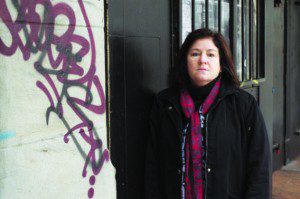 Susan Clairmont and her colleague John Rennison are fleeing to safety. It’s April 2003 and Clairmont is covering the case of Maria Figliola, who stands accused of hiring a hitman to kill her husband. According to prosecutors, she wanted her husband gone and she wanted his money so she could continue to buy her boyfriend lavish gifts such as a slick Mercedes-Benz and a steady supply of cocaine. Clairmont is outside Figliola’s home, but a man at the residence is unhappy with the reporter’s presence. He berates her and Rennison with angry threats of violence. He smashes Rennison’s camera and a car window before the pair manages to get away. They drive to the local hospital where a police car waits.
Susan Clairmont and her colleague John Rennison are fleeing to safety. It’s April 2003 and Clairmont is covering the case of Maria Figliola, who stands accused of hiring a hitman to kill her husband. According to prosecutors, she wanted her husband gone and she wanted his money so she could continue to buy her boyfriend lavish gifts such as a slick Mercedes-Benz and a steady supply of cocaine. Clairmont is outside Figliola’s home, but a man at the residence is unhappy with the reporter’s presence. He berates her and Rennison with angry threats of violence. He smashes Rennison’s camera and a car window before the pair manages to get away. They drive to the local hospital where a police car waits.
“It was definitely one of the scariest moments of my career,” says Clairmont, who has been a crime reporter and columnist at the Hamilton Spectator for 17 years, covering numerous murders and tragedies. Her crime coverage has taken her across Hamilton, creating what her husband jokingly calls her “murder tour.” When she drives by quiet homes and suburban streets, she talks openly about the cases that led her there.
Murder has always captivated journalists. The notorious Jack the Ripper, who terrorized London in the late 1880s, is still infamous today. By the 20th century, stories of American serial killers like Ted Bundy, John Wayne Gacy and Jeffrey Dahmer made national headlines. Then, in the early 1990s, Canadians became engrossed in the case of Paul Bernardo and
Karla Homolka.
Today, the widespread success of Sarah Koenig’s podcast Serial has tapped into the human attraction to true crime stories. The first season of the series analyzes the minute details of a single case: the murder of teenager Hae Min Lee in 1999. The podcast recounts in 12 episodes Koenig’s year-long research into Adnan Syed’s controversial trials and conviction for Lee’s murder. The former Baltimore Sun reporter draws listeners in by taking them through the events of the investigation into Syed’s case. Often, when listeners form opinions about Syed’s guilt, Koenig presents information that casts doubt and changes minds. She expresses her own confusion with the case and shares her views with the listener. The podcast forces listeners to ponder life behind bars, or worse, life as a wrongly convicted prison inmate. Koenig becomes a character herself, the model of a reporter-turned-detective digging deeply into a case. One of the reasons Serial is successful is that it involves listeners in the story by raising questions, inciting empathy and encouraging opinion. Serial, created by four women—Koenig and her production team—is an example of crime reporting at its best.
Historical stereotypes see the crime beat, like much of journalism, as primarily a man’s game. But in Canada, women have been strong voices in crime reporting for decades. Female reporters have helped redefine crime journalism and they’re responsible for some of this country’s most powerful stories.
***
While some reporters say gender no longer plays a major role in the newsroom, an academic paper published in 2012 by Ann Rauhala, April Lindgren and Sahar Fatima of Ryerson University found otherwise. “Influential beats such as politics and crime remain male-dominated, with women covering a third of those stories,” it states. Their paper cites studies that found women reported only 37 percent of crime stories in 2005, even though crime and politics (two male-dominated beats grouped together in the report) accounted for 50 percent of all news stories.
Still, women are increasingly some of Canada’s leading crime reporters—from Rhiannon Russell at the Whitehorse Star, to April Cunningham at The Telegraph-Journal in Saint John, New Brunswick and Kim Bolan at The Vancouver Sun. Catherine McKercher, a journalism professor emeritus at Carleton University, says it was inevitable for women to become leading voices in crime reporting as more and more women enter newsrooms once overpopulated with male reporters. Chasing criminals, she says, is unpredictable regardless of the reporter’s gender. “It’s a dangerous place for a man to be, too. Why is it more difficult for a reporter just because she’s a woman?”
Clairmont has never questioned her place as a crime reporter. She was always a curious person. On a day when she stayed home sick from grade school, she browsed her mother’s extensive book collection, choosing Truman Capote’s true crime classic In Cold Blood from the shelf. The book contributed to her fascination with crime.
“If I didn’t get into journalism school, I would’ve gone to law school,” she says. Her interest in crime was piqued again when one of her graduate journalism school classes sat in on the
infamous Guy Paul Morin murder and rape trial. In the
courtroom, the case of a man who would be convicted and later exonerated held her attention. She found herself returning to the trial without her classmates.
After completing graduate school, Clairmont began working the crime beat following a gig as a general assignment reporter at The Peterborough Examiner. She was unfazed by danger. While five-months pregnant with her first child, she spent a week covering 9/11 in New York City. “That probably wasn’t the smartest thing I could’ve done,” Clairmont admits, but her curiosity makes her someone who cannot stay away from a story.
For some time now, Clairmont has been covering the double murder trial of Mark Staples, who was arrested in 2010 for the murder of his father and sister. His motive, according to the prosecutors, was money. On a day in late October, the modern, chilly room on the sixth floor of the John Sopinka Courthouse in Hamilton, Ontario, is almost devoid of Staples supporters. While the lawyers present evidence and witnesses take the stand, Clairmont listens intently and occasionally stops taking notes on her iPad to grab her smartphone and live-tweet case updates, which her newsroom colleagues later post on Storify. On an hour-long recess, Clairmont retreats to the media office at the courthouse, uploading a quick brief about the morning’s events.
During her lunch breaks throughout the trial, Clairmont frequently sees Staples. But encountering those accused of heinous crimes outside the courtroom does not seem to throw her—Clairmont has covered some of the most grisly crimes in the city. She reconciles gruesome details and ordinary human interaction every day.
When she started at the Examiner, she primarily worked with men and says she sought to mimic their unemotional attitudes and their focus on perpetrators. Now, her coverage focuses on more than just the accused. She’s particularly passionate about the victims, sometimes preferring to write about them rather than the accused. In reporting on the Staples case, she uncovered that his sister, Rhonda Borelli, had a son whom she gave up after the boy’s father died. She tracked him down and wrote an article introducing readers to a sweet 21-year-old named William Swayze, whose biological parents were both dead by the time he was four.
***
On the west coast, Kim Bolan has spent more than 30 years on the job. During that time, she has covered murders, gangs and terrorism in B.C. Crime had always sparked her interest, but her reporting on the bombing of Air India Flight 182 solidified her status as a crime-reporting legend. For three years after the explosion that killed 329 people, she followed three men accused of being involved in the bombing. Years later, she still speaks to families of victims and attends memorial services, writing about them to help the community remember those who were lost. She reported the story despite the assassination of fellow journalist Tara Singh Hayer and the harassment of witnesses, newspaper publishers and reporters. While chasing the story, she travelled to Punjab, India, five times in 20 years, meeting with high-ranking Sikh extremists, along with victims of their violence. She also followed one of the accused men to Pakistan before he was slain in India and tracked down other suspects across the country and in England.
In 1998, Bolan received information that a group she was covering held a meeting to discuss “knocking people off.” Police warned her that she was a target and to exercise caution. In July, while her family was asleep, the sound of a gunshot resonated outside her home. She was awake to hear the shot and a car speeding away. She ran to her bathroom and called 911. Police suspected that people close to the Air India bombers were behind the warning shot. Sikh fundamentalist groups had previously sent her death threats. She investigated terrorist groups in B.C. and was later placed under  police protection. The bullet, she says, was meant as both a retaliation and a warning to silence her.
police protection. The bullet, she says, was meant as both a retaliation and a warning to silence her.
Bolan is gruff and intimidating. She worked with police informant Micheal Plante, who infiltrated the Vancouver chapter of Hells Angels and became a part of the Angels’ drug enterprise. She eventually wrote a six-part series about his time with the gang. The Vancouver Sun exclusive detailed how Plante’s undercover work led to the arrest and conviction of a dozen members and associates of the gang. The investigative series about Plante’s time undercover came largely from Bolan’s experience interviewing him directly, rather than from information provided by the authorities. If she can’t get what she needs from the police, she says, she’ll get it straight from those with firsthand experience.
In the early 2000s, Bolan helped investigate the disappearances of 45 Vancouver-area women, mostly sex workers from the Downtown Eastside. As the list of missing women grew, Bolan and Sun colleague Lindsay Kines kept the story on the front page.
Bolan was on the driveway of Robert Pickton’s Port Coquitlam, B.C., pig farm the night the police executed their first warrant. Her reportage recognized the tragedy of what she witnessed, but was clear and informative. After speaking to an RCMP constable, she wrote: “The excavation and search for human remains at the [farm] resembles the massive undertaking at Ground Zero after the World Trade Center disaster.” Her writing often shows great empathy. She interviewed Pickton’s sister, Linda, who had pleaded with journalists to leave her and her family alone. After Linda reluctantly agreed to speak publicly, Bolan wrote an article discussing the family’s lives after Robert was charged, mixing facts about the family’s finances with clear sympathy for their emotional trauma.
In both 2011 and 2012, Bolan won the Canadian Association of Journalists prize for Daily Excellence. The Vancouver Sun’s editor-in-chief Harold Munro praised her work: “Kim is the best crime reporter in Canada because of her passion for storytelling and relentless pursuit of the truth. She courageously takes on difficult stories—even in the face of tremendous risk to her personal safety.” More than a decade after Pickton’s arrest, Bolan wrote a follow-up about several missing sex workers in a post-Pickton B.C.
***
A new generation is continuing the crime-reporting tradition in its own way, leaving a mark on a beat that always draws attention. Before Robyn Doolittle became known as the Toronto Star reporter who exposed Rob Ford’s crack use, she got her start working the crime beat and making important connections in the police force.
 She wasn’t the only one. Tamara Cherry moved from writing about crime in The Toronto Sun to reporting crime on television for CTV, covering many high-profile cases in and around Toronto. Cherry has occasionally felt uncomfortable—when canvassing high-crime areas, for instance—but she says she’s never found herself in a position that “my mother would worry about.”
She wasn’t the only one. Tamara Cherry moved from writing about crime in The Toronto Sun to reporting crime on television for CTV, covering many high-profile cases in and around Toronto. Cherry has occasionally felt uncomfortable—when canvassing high-crime areas, for instance—but she says she’s never found herself in a position that “my mother would worry about.”
At 30, Cherry’s passion for the crime beat is clear. “I once wanted to go work in Detroit because the crime rate was so high and I thought it would be an exciting place to be a crime reporter,” she says. She decided against the move because she read a local newspaper and noticed most murders did not receive much attention. “I’m happy to live in a country where every murder is a big deal, where we haven’t become complacent when it comes to crime even though our numbers are drastically lower than those south of the border.”
Last May, shortly after Dellen Millard was arrested for the murder of Tim Bosma, Cherry revealed that Millard had exchanged 13 phone calls with another missing person, 23-year-old Laura Babcock. Police had access to the phone records, but it was Cherry’s investigative work that connected these two cases.
Journalists who deliver the best crime coverage recognize their duty to uncover a story, write about it and capture the reader’s attention. And more and more, in Canada at least, if the question is “Whodunit?” women are increasingly the ones answering.
Photos by Megan Matsuda
About the author
Ryerson Journalism Student. Writer for the Spring 2015 Ryerson Review of Journalism.
